A cross - cultural perspective of speech acts and its application to efl classrooms
Speech acts, the actions performed by utterances, play an important role in
communication, particularly verbally. Speech act performance requires not
only knowledge of the language, but also knowledge about the appropriate
use of that language in a certain situation within a particular culture. As a
result, cultural awareness constitutes an integral part of this important area
of pragmatics. This study provides some insights into the use of speech acts
by Vietnamese EFL learners from a cross-cultural perspective. It is
suggested that the influence of culture has resulted in students’ common
failures to understand and perform English speech acts. To minimize this
kind of pragmatic failure, it is recommended that EFL teachers raise
students’ awareness of some cultural issues in cross-cultural
communication. Furthermore, it is necessary to incorporate speech acts into
English language teaching with authentic input and lifelike communicative activities.
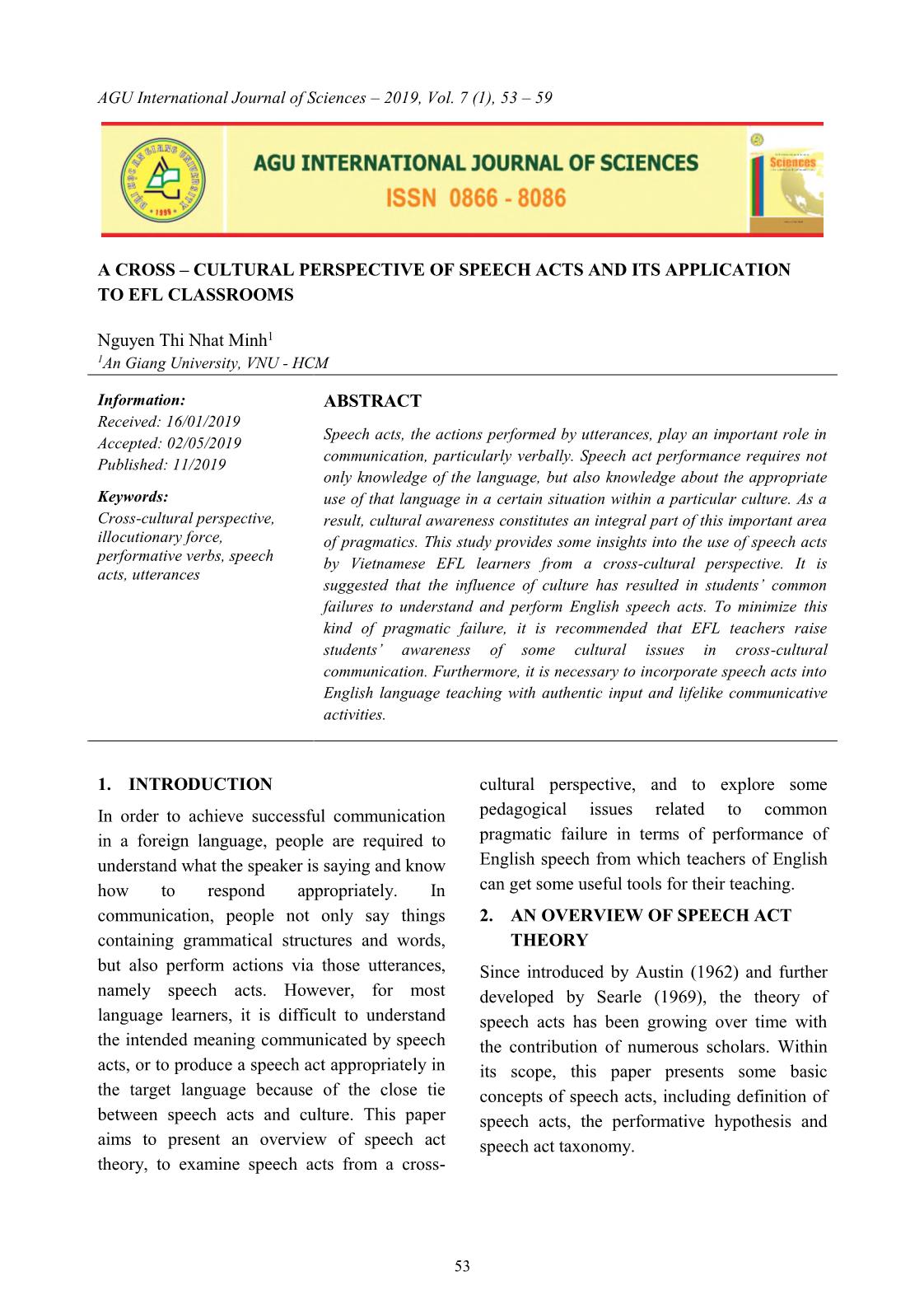
Trang 1
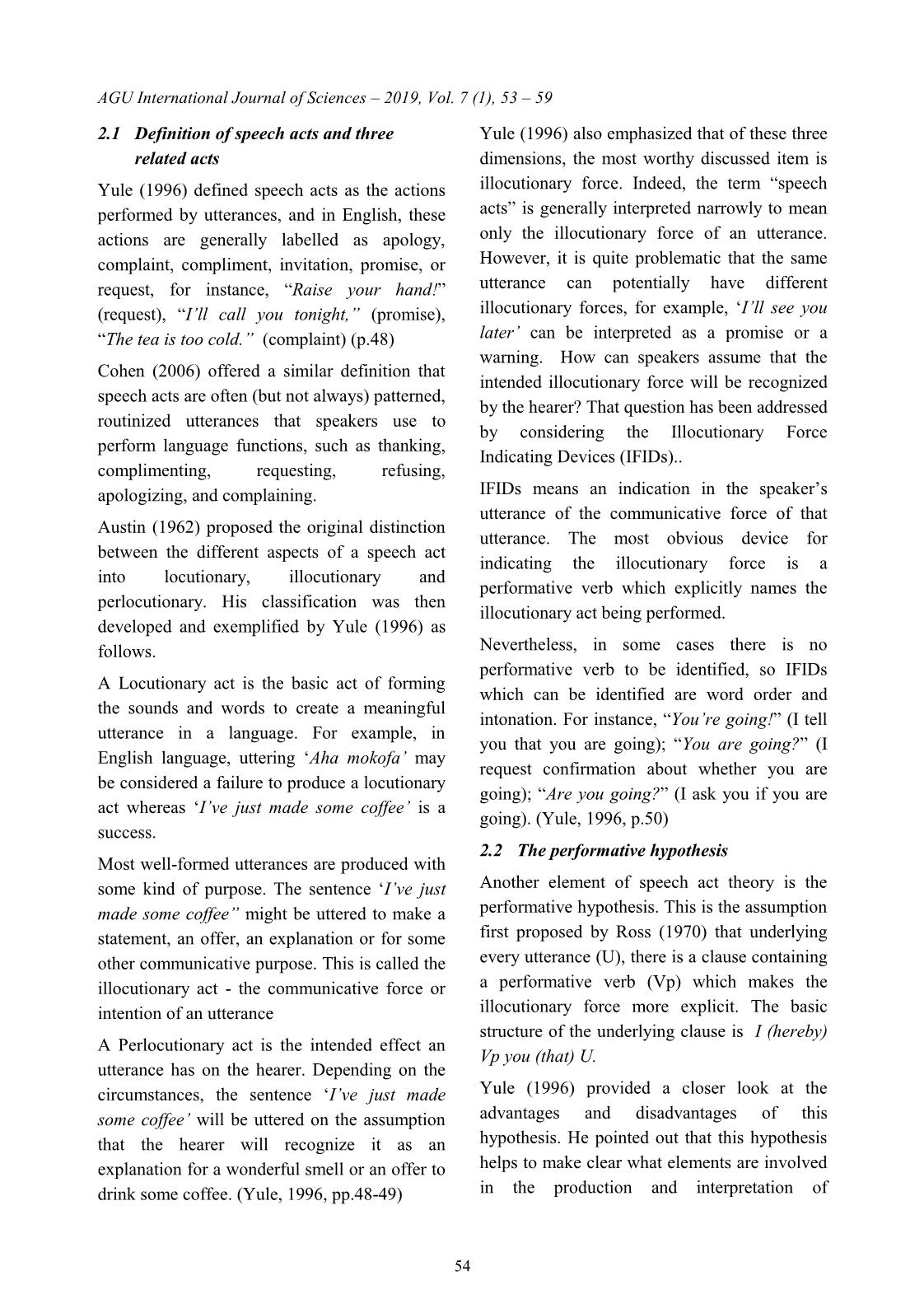
Trang 2

Trang 3
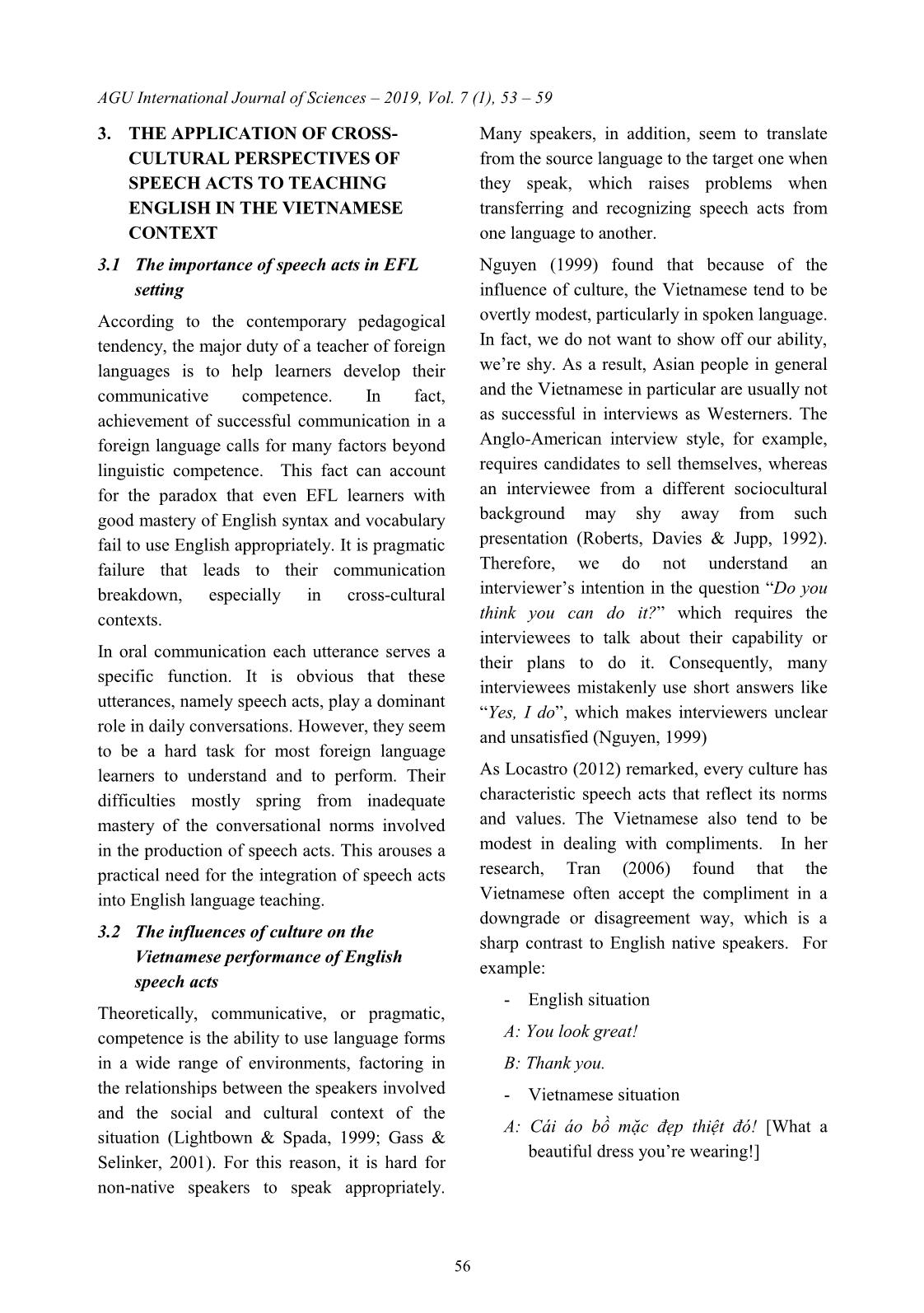
Trang 4
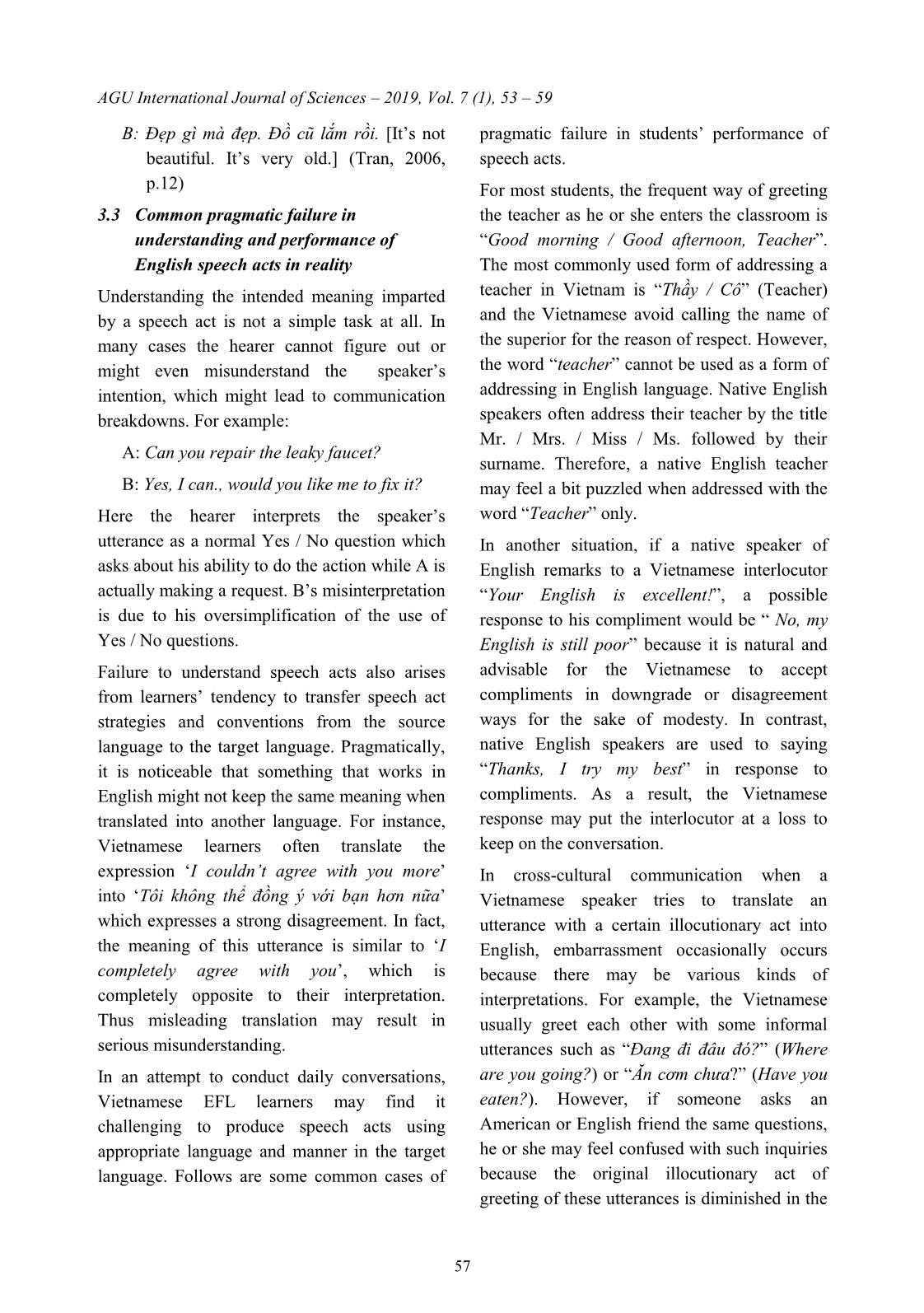
Trang 5
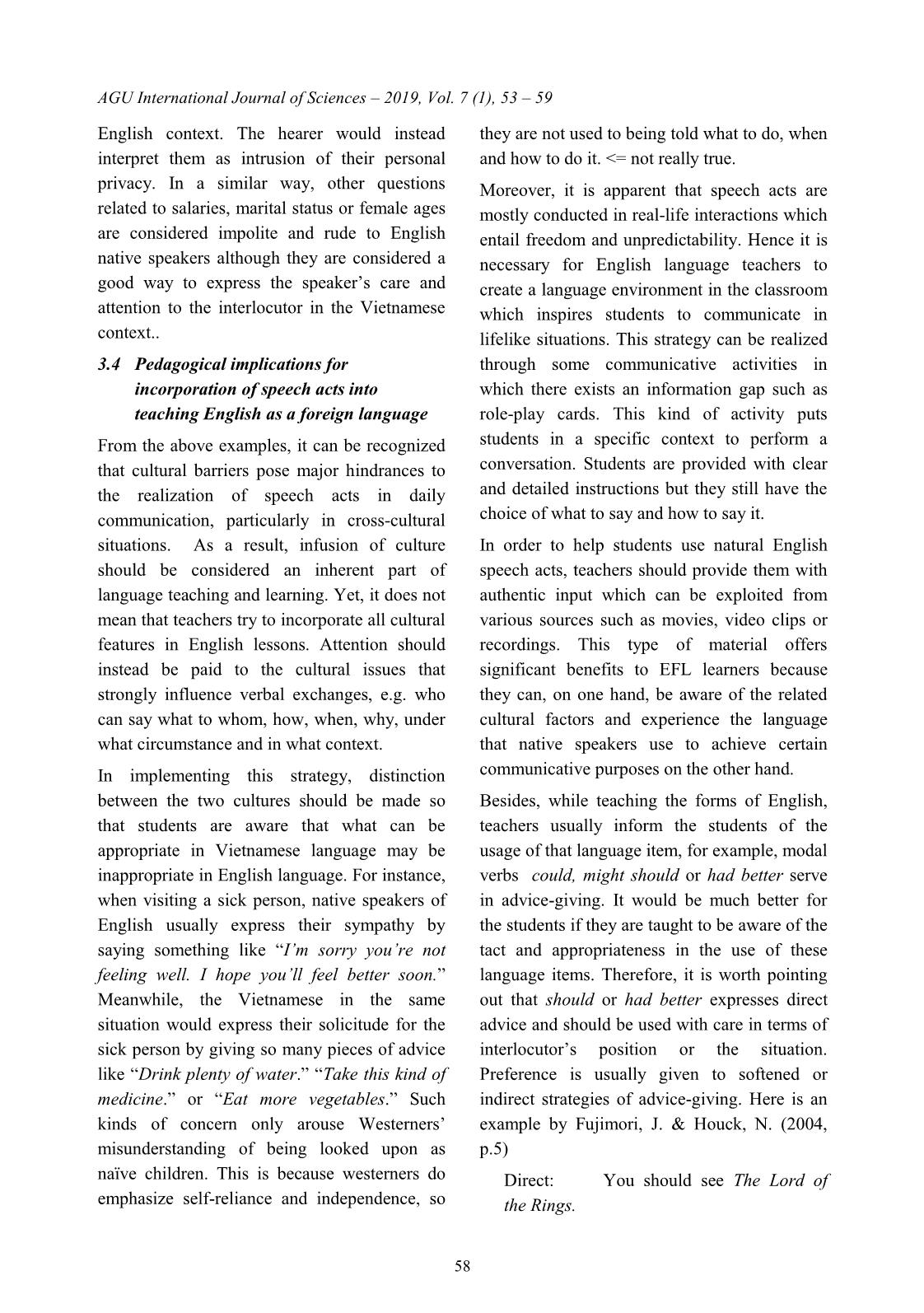
Trang 6
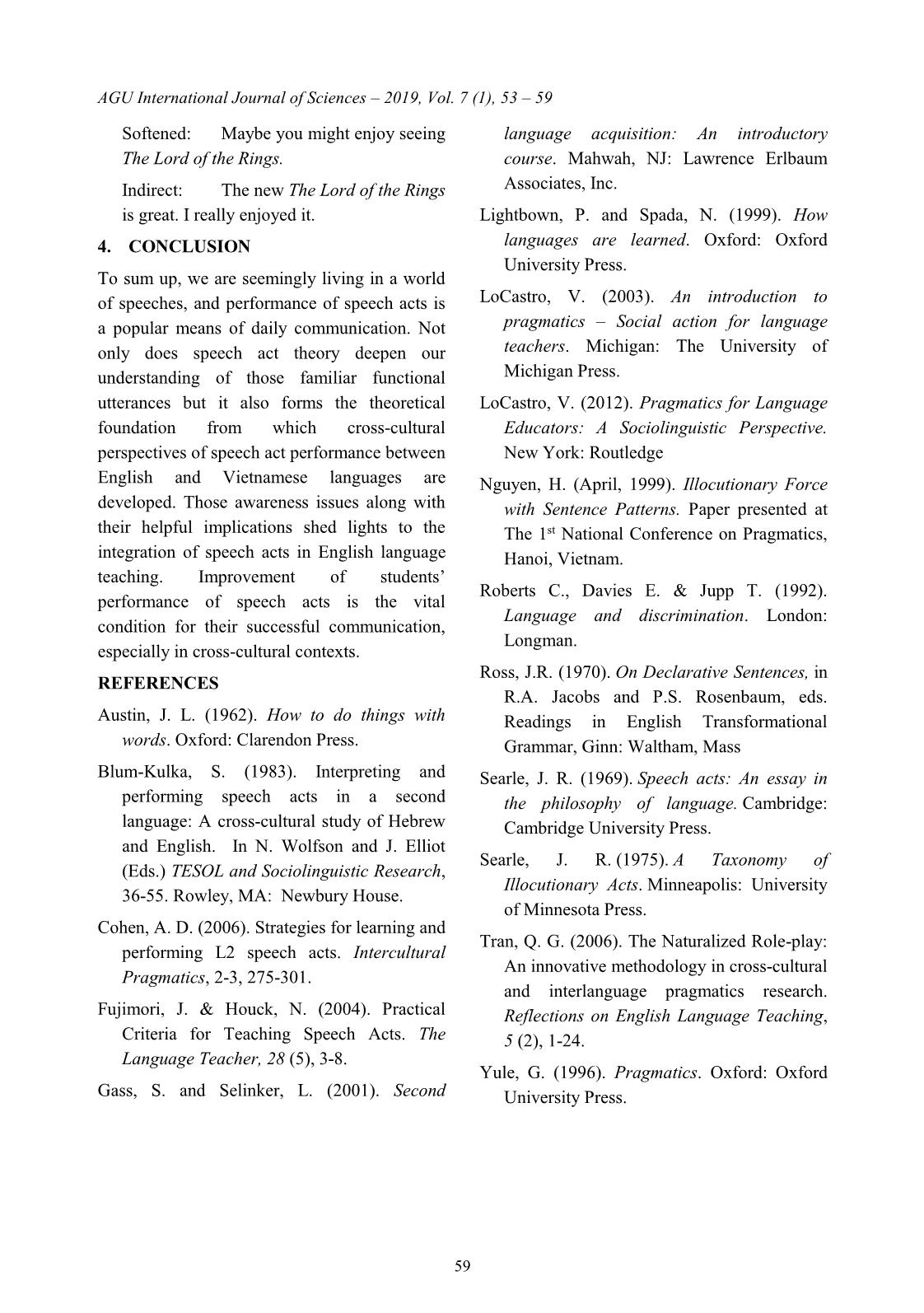
Trang 7
Tóm tắt nội dung tài liệu: A cross - cultural perspective of speech acts and its application to efl classrooms
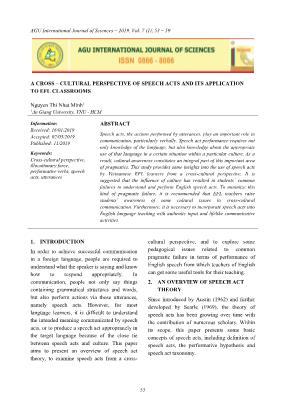
AGU International Journal of Sciences – 2019, Vol. 7 (1), 53 – 59 53 A CROSS – CULTURAL PERSPECTIVE OF SPEECH ACTS AND ITS APPLICATION TO EFL CLASSROOMS Nguyen Thi Nhat Minh1 1An Giang University, VNU - HCM Information: Received: 16/01/2019 Accepted: 02/05/2019 Published: 11/2019 Keywords: Cross-cultural perspective, illocutionary force, performative verbs, speech acts, utterances ABSTRACT Speech acts, the actions performed by utterances, play an important role in communication, particularly verbally. Speech act performance requires not only knowledge of the language, but also knowledge about the appropriate use of that language in a certain situation within a particular culture. As a result, cultural awareness constitutes an integral part of this important area of pragmatics. This study provides some insights into the use of speech acts by Vietnamese EFL learners from a cross-cultural perspective. It is suggested that the influence of culture has resulted in students’ common failures to understand and perform English speech acts. To minimize this kind of pragmatic failure, it is recommended that EFL teachers raise students’ awareness of some cultural issues in cross-cultural communication. Furthermore, it is necessary to incorporate speech acts into English language teaching with authentic input and lifelike communicative activities. 1. INTRODUCTION In order to achieve successful communication in a foreign language, people are required to understand what the speaker is saying and know how to respond appropriately. In communication, people not only say things containing grammatical structures and words, but also perform actions via those utterances, namely speech acts. However, for most language learners, it is difficult to understand the intended meaning communicated by speech acts, or to produce a speech act appropriately in the target language because of the close tie between speech acts and culture. This paper aims to present an overview of speech act theory, to examine speech acts from a cross- cultural perspective, and to explore some pedagogical issues related to common pragmatic failure in terms of performance of English speech from which teachers of English can get some useful tools for their teaching. 2. AN OVERVIEW OF SPEECH ACT THEORY Since introduced by Austin (1962) and further developed by Searle (1969), the theory of speech acts has been growing over time with the contribution of numerous scholars. Within its scope, this paper presents some basic concepts of speech acts, including definition of speech acts, the performative hypothesis and speech act taxonomy. AGU International Journal of Sciences – 2019, Vol. 7 (1), 53 – 59 54 2.1 Definition of speech acts and three related acts Yule (1996) defined speech acts as the actions performed by utterances, and in English, these actions are generally labelled as apology, complaint, compliment, invitation, promise, or request, for instance, “Raise your hand!” (request), “I’ll call you tonight,” (promise), “The tea is too cold.” (complaint) (p.48) Cohen (2006) offered a similar definition that speech acts are often (but not always) patterned, routinized utterances that speakers use to perform language functions, such as thanking, complimenting, requesting, refusing, apologizing, and complaining. Austin (1962) proposed the original distinction between the different aspects of a speech act into locutionary, illocutionary and perlocutionary. His classification was then developed and exemplified by Yule (1996) as follows. A Locutionary act is the basic act of forming the sounds and words to create a meaningful utterance in a language. For example, in English language, uttering ‘Aha mokofa’ may be considered a failure to produce a locutionary act whereas ‘I’ve just made some coffee’ is a success. Most well-formed utterances are produced with some kind of purpose. The sentence ‘I’ve just made some coffee” might be uttered to make a statement, an offer, an explanation or for some other communicative purpose. This is called the illocutionary act - the communicative force or intention of an utterance A Perlocutionary act is the intended effect an utterance has on the hearer. Depending on the circumstances, the sentence ‘I’ve just made some coffee’ will be uttered on the assumption that the hearer will recognize it as an explanation for a wonderful smell or an offer to drink some coffee. (Yule, 1996, pp.48-49) Yule (1996) also emphasized that of these three dimensions, the most worthy discussed item is illocutionary force. Indeed, the term “speech acts” is generally interpreted narrowly to mean only the illocutionary force of an utterance. However, it is quite problematic that the same utterance can potentially have different illocutionary forces, for example, ‘I’ll see you later’ can be interpreted as a promise or a warning. How can speakers assume that the intended illocutionary force will be recognized by the hearer? That question has been addressed by considering the Illocutionary Force Indicating Devices (IFIDs).. IFIDs means an indication in the speaker’s utterance of the communicative force of that utterance. The most obvious device for indicating the illocutionary force is a performative verb which explicitly names the illocutionary act being performed. Nevertheless, in some cases there is no performative verb to be identified, so IFIDs which can be identified are word order and intonation. For instance, “You’re going!” (I tell you that you are going); “You are going?” (I request confirmation about whether you are going); “Are you going?” (I ask you if you are going). (Yule, 1996, p.50) 2.2 The performative hypothesis Another element of speech act theory is the performa ... OF SPEECH ACTS TO TEACHING ENGLISH IN THE VIETNAMESE CONTEXT 3.1 The importance of speech acts in EFL setting According to the contemporary pedagogical tendency, the major duty of a teacher of foreign languages is to help learners develop their communicative competence. In fact, achievement of successful communication in a foreign language calls for many factors beyond linguistic competence. This fact can account for the paradox that even EFL learners with good mastery of English syntax and vocabulary fail to use English appropriately. It is pragmatic failure that leads to their communication breakdown, especially in cross-cultural contexts. In oral communication each utterance serves a specific function. It is obvious that these utterances, namely speech acts, play a dominant role in daily conversations. However, they seem to be a hard task for most foreign language learners to understand and to perform. Their difficulties mostly spring from inadequate mastery of the conversational norms involved in the production of speech acts. This arouses a practical need for the integration of speech acts into English language teaching. 3.2 The influences of culture on the Vietnamese performance of English speech acts Theoretically, communicative, or pragmatic, competence is the ability to use language forms in a wide range of environments, factoring in the relationships between the speakers involved and the social and cultural context of the situation (Lightbown & Spada, 1999; Gass & Selinker, 2001). For this reason, it is hard for non-native speakers to speak appropriately. Many speakers, in addition, seem to translate from the source language to the target one when they speak, which raises problems when transferring and recognizing speech acts from one language to another. Nguyen (1999) found that because of the influence of culture, the Vietnamese tend to be overtly modest, particularly in spoken language. In fact, we do not want to show off our ability, we’re shy. As a result, Asian people in general and the Vietnamese in particular are usually not as successful in interviews as Westerners. The Anglo-American interview style, for example, requires candidates to sell themselves, whereas an interviewee from a different sociocultural background may shy away from such presentation (Roberts, Davies & Jupp, 1992). Therefore, we do not understand an interviewer’s intention in the question “Do you think you can do it?” which requires the interviewees to talk about their capability or their plans to do it. Consequently, many interviewees mistakenly use short answers like “Yes, I do”, which makes interviewers unclear and unsatisfied (Nguyen, 1999) As Locastro (2012) remarked, every culture has characteristic speech acts that reflect its norms and values. The Vietnamese also tend to be modest in dealing with compliments. In her research, Tran (2006) found that the Vietnamese often accept the compliment in a downgrade or disagreement way, which is a sharp contrast to English native speakers. For example: - English situation A: You look great! B: Thank you. - Vietnamese situation A: Cái áo bồ mặc đẹp thiệt đó! [What a beautiful dress you’re wearing!] AGU International Journal of Sciences – 2019, Vol. 7 (1), 53 – 59 57 B: Đẹp gì mà đẹp. Đồ cũ lắm rồi. [It’s not beautiful. It’s very old.] (Tran, 2006, p.12) 3.3 Common pragmatic failure in understanding and performance of English speech acts in reality Understanding the intended meaning imparted by a speech act is not a simple task at all. In many cases the hearer cannot figure out or might even misunderstand the speaker’s intention, which might lead to communication breakdowns. For example: A: Can you repair the leaky faucet? B: Yes, I can., would you like me to fix it? Here the hearer interprets the speaker’s utterance as a normal Yes / No question which asks about his ability to do the action while A is actually making a request. B’s misinterpretation is due to his oversimplification of the use of Yes / No questions. Failure to understand speech acts also arises from learners’ tendency to transfer speech act strategies and conventions from the source language to the target language. Pragmatically, it is noticeable that something that works in English might not keep the same meaning when translated into another language. For instance, Vietnamese learners often translate the expression ‘I couldn’t agree with you more’ into ‘Tôi không thể đồng ý với bạn hơn nữa’ which expresses a strong disagreement. In fact, the meaning of this utterance is similar to ‘I completely agree with you’, which is completely opposite to their interpretation. Thus misleading translation may result in serious misunderstanding. In an attempt to conduct daily conversations, Vietnamese EFL learners may find it challenging to produce speech acts using appropriate language and manner in the target language. Follows are some common cases of pragmatic failure in students’ performance of speech acts. For most students, the frequent way of greeting the teacher as he or she enters the classroom is “Good morning / Good afternoon, Teacher”. The most commonly used form of addressing a teacher in Vietnam is “Thầy / Cô” (Teacher) and the Vietnamese avoid calling the name of the superior for the reason of respect. However, the word “teacher” cannot be used as a form of addressing in English language. Native English speakers often address their teacher by the title Mr. / Mrs. / Miss / Ms. followed by their surname. Therefore, a native English teacher may feel a bit puzzled when addressed with the word “Teacher” only. In another situation, if a native speaker of English remarks to a Vietnamese interlocutor “Your English is excellent!”, a possible response to his compliment would be “ No, my English is still poor” because it is natural and advisable for the Vietnamese to accept compliments in downgrade or disagreement ways for the sake of modesty. In contrast, native English speakers are used to saying “Thanks, I try my best” in response to compliments. As a result, the Vietnamese response may put the interlocutor at a loss to keep on the conversation. In cross-cultural communication when a Vietnamese speaker tries to translate an utterance with a certain illocutionary act into English, embarrassment occasionally occurs because there may be various kinds of interpretations. For example, the Vietnamese usually greet each other with some informal utterances such as “Đang đi đâu đó?” (Where are you going?) or “Ăn cơm chưa?” (Have you eaten?). However, if someone asks an American or English friend the same questions, he or she may feel confused with such inquiries because the original illocutionary act of greeting of these utterances is diminished in the AGU International Journal of Sciences – 2019, Vol. 7 (1), 53 – 59 58 English context. The hearer would instead interpret them as intrusion of their personal privacy. In a similar way, other questions related to salaries, marital status or female ages are considered impolite and rude to English native speakers although they are considered a good way to express the speaker’s care and attention to the interlocutor in the Vietnamese context.. 3.4 Pedagogical implications for incorporation of speech acts into teaching English as a foreign language From the above examples, it can be recognized that cultural barriers pose major hindrances to the realization of speech acts in daily communication, particularly in cross-cultural situations. As a result, infusion of culture should be considered an inherent part of language teaching and learning. Yet, it does not mean that teachers try to incorporate all cultural features in English lessons. Attention should instead be paid to the cultural issues that strongly influence verbal exchanges, e.g. who can say what to whom, how, when, why, under what circumstance and in what context. In implementing this strategy, distinction between the two cultures should be made so that students are aware that what can be appropriate in Vietnamese language may be inappropriate in English language. For instance, when visiting a sick person, native speakers of English usually express their sympathy by saying something like “I’m sorry you’re not feeling well. I hope you’ll feel better soon.” Meanwhile, the Vietnamese in the same situation would express their solicitude for the sick person by giving so many pieces of advice like “Drink plenty of water.” “Take this kind of medicine.” or “Eat more vegetables.” Such kinds of concern only arouse Westerners’ misunderstanding of being looked upon as naïve children. This is because westerners do emphasize self-reliance and independence, so they are not used to being told what to do, when and how to do it. <= not really true. Moreover, it is apparent that speech acts are mostly conducted in real-life interactions which entail freedom and unpredictability. Hence it is necessary for English language teachers to create a language environment in the classroom which inspires students to communicate in lifelike situations. This strategy can be realized through some communicative activities in which there exists an information gap such as role-play cards. This kind of activity puts students in a specific context to perform a conversation. Students are provided with clear and detailed instructions but they still have the choice of what to say and how to say it. In order to help students use natural English speech acts, teachers should provide them with authentic input which can be exploited from various sources such as movies, video clips or recordings. This type of material offers significant benefits to EFL learners because they can, on one hand, be aware of the related cultural factors and experience the language that native speakers use to achieve certain communicative purposes on the other hand. Besides, while teaching the forms of English, teachers usually inform the students of the usage of that language item, for example, modal verbs could, might should or had better serve in advice-giving. It would be much better for the students if they are taught to be aware of the tact and appropriateness in the use of these language items. Therefore, it is worth pointing out that should or had better expresses direct advice and should be used with care in terms of interlocutor’s position or the situation. Preference is usually given to softened or indirect strategies of advice-giving. Here is an example by Fujimori, J. & Houck, N. (2004, p.5) Direct: You should see The Lord of the Rings. AGU International Journal of Sciences – 2019, Vol. 7 (1), 53 – 59 59 Softened: Maybe you might enjoy seeing The Lord of the Rings. Indirect: The new The Lord of the Rings is great. I really enjoyed it. 4. CONCLUSION To sum up, we are seemingly living in a world of speeches, and performance of speech acts is a popular means of daily communication. Not only does speech act theory deepen our understanding of those familiar functional utterances but it also forms the theoretical foundation from which cross-cultural perspectives of speech act performance between English and Vietnamese languages are developed. Those awareness issues along with their helpful implications shed lights to the integration of speech acts in English language teaching. Improvement of students’ performance of speech acts is the vital condition for their successful communication, especially in cross-cultural contexts. REFERENCES Austin, J. L. (1962). How to do things with words. Oxford: Clarendon Press. Blum-Kulka, S. (1983). Interpreting and performing speech acts in a second language: A cross-cultural study of Hebrew and English. In N. Wolfson and J. Elliot (Eds.) TESOL and Sociolinguistic Research, 36-55. Rowley, MA: Newbury House. Cohen, A. D. (2006). Strategies for learning and performing L2 speech acts. Intercultural Pragmatics, 2-3, 275-301. Fujimori, J. & Houck, N. (2004). Practical Criteria for Teaching Speech Acts. The Language Teacher, 28 (5), 3-8. Gass, S. and Selinker, L. (2001). Second language acquisition: An introductory course. Mahwah, NJ: Lawrence Erlbaum Associates, Inc. Lightbown, P. and Spada, N. (1999). How languages are learned. Oxford: Oxford University Press. LoCastro, V. (2003). An introduction to pragmatics – Social action for language teachers. Michigan: The University of Michigan Press. LoCastro, V. (2012). Pragmatics for Language Educators: A Sociolinguistic Perspective. New York: Routledge Nguyen, H. (April, 1999). Illocutionary Force with Sentence Patterns. Paper presented at The 1st National Conference on Pragmatics, Hanoi, Vietnam. Roberts C., Davies E. & Jupp T. (1992). Language and discrimination. London: Longman. Ross, J.R. (1970). On Declarative Sentences, in R.A. Jacobs and P.S. Rosenbaum, eds. Readings in English Transformational Grammar, Ginn: Waltham, Mass Searle, J. R. (1969). Speech acts: An essay in the philosophy of language. Cambridge: Cambridge University Press. Searle, J. R. (1975). A Taxonomy of Illocutionary Acts. Minneapolis: University of Minnesota Press. Tran, Q. G. (2006). The Naturalized Role-play: An innovative methodology in cross-cultural and interlanguage pragmatics research. Reflections on English Language Teaching, 5 (2), 1-24. Yule, G. (1996). Pragmatics. Oxford: Oxford University Press.
File đính kèm:
 a_cross_cultural_perspective_of_speech_acts_and_its_applicat.pdf
a_cross_cultural_perspective_of_speech_acts_and_its_applicat.pdf

